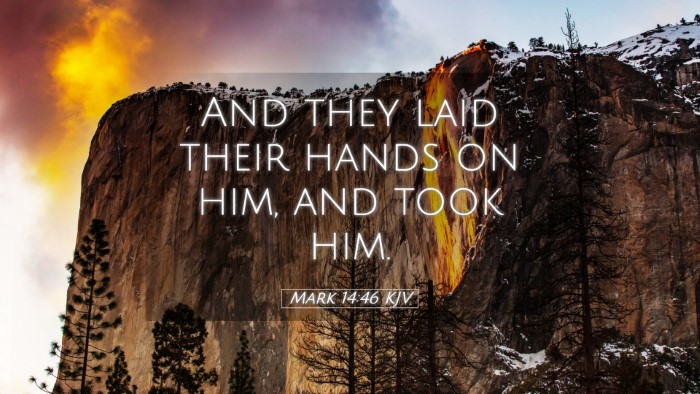Commentary on Mark 14:46
In Mark 14:46, we witness a pivotal moment in the narrative of the Passion of Christ. The verse records, "And they laid their hands on him, and took him." This succinct statement encapsulates the arrest of Jesus, a significant event leading to his crucifixion. Understanding this moment requires careful theological reflection and analysis.
Contextual Background
The events of Mark 14 occur during the final hours before Jesus' crucifixion. The context is set in the darkness of the Garden of Gethsemane, where Jesus, in anguish, has been praying. This scene highlights the betrayal, the culmination of a systematic rejection of Jesus by religious authorities, and the mounting tension leading to his sacrifice.
Insights from Matthew Henry
Matthew Henry, in his expository works, delves into the profound implications of this arrest. He emphasizes the fulfillment of prophecy and the voluntary nature of Christ's submission to arrest. Jesus went willingly, demonstrating ultimate obedience to the Father’s will, which signifies the necessity of his sacrifice for humanity's redemption.
- Obedience and Submission: Henry notes that even in the face of persecution and impending crucifixion, Christ's submission reflects his profound love for humanity and the will of God.
- Fulfillment of Prophecy: The act of surrendering to the authorities was foreshadowed by the prophets, demonstrating God’s sovereign plan throughout Scripture.
Insights from Albert Barnes
Albert Barnes adds depth, focusing on the actions of the captors and the implications of their violence. He explores the nature of the betrayal by Judas, who identified Jesus with a kiss, and the role of the guards sent to seize him. Barnes draws attention to the brutality of the arrest and how it symbolizes the darker aspects of human nature that leads to the rejection of the Divine.
- Violence and Betrayal: Barnes highlights the significance of the kiss, symbolizing treachery. This moment reveals the depths of human sin and the lengths to which the enemies of Christ would go to destroy him.
- Divine Restraint: In the midst of the chaos, Barnes points out Christ’s calm demeanor, which underscores His divine nature. Unlike any other figure facing arrest, He does not resist but rather embraces his fate willingly.
Insights from Adam Clarke
Adam Clarke provides a more detailed examination of the passage, relating to the cultural practices of the time. He elaborates on the nature of the arrest and how it was carried out with the intention of ensuring that there would be no opposition from Jesus’ followers. Clarke emphasizes how the forces of darkness used deception and violence to achieve their ends.
- Cultural Context: Clarke notes that the Jewish leaders took great pains to ensure that the arrest was unexpected and swift, reflecting their fear of popular support for Jesus.
- The Role of the Disciples: Clarke comments on the reactions of the disciples to the arrest, noting their fear and eventual scattering, which fulfills the prophecies about the disciples leaving Jesus alone in his hour of need.
Theological Implications
The arrest of Jesus as recorded in Mark 14:46 is not merely a historical event; it is laden with theological significance. Each commentator draws us back to the heart of the Gospel message, emphasizing themes of betrayal, sacrifice, and divine sovereignty.
- The Nature of Christ’s Kingship: Jesus’ silent acceptance of his arrest starkly contrasts the expectations of a militant Messiah. He redefines kingship through suffering, thereby inaugurating a new understanding of authority and power.
- Human Sinfulness: This moment illustrates the depths of human fallibility and the readiness to conspire against divine goodness. Each action taken against Jesus points back to our need for redemption.
- God's Sovereignty: Despite the apparent chaos, the arrest of Jesus is part of a divine plan. The execution of God’s salvation history reassures believers of God’s ultimate control over human affairs.
Reflections for Pastors and Theologians
Mark 14:46 serves as a poignant reminder for pastors and theologians of the gravity of Christ’s mission. It calls for deeper contemplation of the nature of discipleship in light of betrayal, the strength in vulnerability, and the heroic obedience of Christ.
- Pastoral Care: Understanding the human experiences of fear and betrayal can inform pastoral responses to congregational struggles. Providing comfort and encouraging obedience to God’s will is vital.
- Theological Study: The incident invites robust theological engagement regarding the mystery of the Incarnation, suffering, and the implications for Christian life today.
Conclusion
Mark 14:46 succinctly encapsulates a moment of turmoil, obedience, and divine fulfillment. Through the eyes of Matthew Henry, Albert Barnes, and Adam Clarke, we are challenged to see the gravity of Christ’s arrest and its implications for understanding the nature of sin and redemption. This verse invites ongoing contemplation, prayer, and application in our lives as believers.


